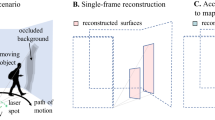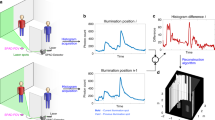Abstract
This work achieves an efficient acquisition of scenes and their depths along long streets. A camera is mounted on a vehicle moving along a straight or a mildly curved path and a sampling line properly set in the camera frame scans the 1D images over scenes continuously to form a 2D route panorama. This paper proposes a method to estimate the depth from the camera path by analyzing a phenomenon called stationary blur in the route panorama. This temporal blur is a perspective effect in parallel projection yielded from the sampling slit with a physical width. We analyze the behavior of the stationary blur with respect to the scene depth, vehicle path, and camera properties. Based on that, we develop an adaptive filter to evaluate the degree of the blur for depth estimation, which avoids error-prone feature matching or tracking in capturing complex street scenes and facilitates real time sensing. The method also uses much less data than the structure from motion approach so that it can extend the sensing area significantly. The resulting route panorama with depth information is useful for urban visualization, monitoring, navigation, and modeling.
Similar content being viewed by others
References
Agarwala, A., et al. (2006). Photographing long scenes with multi-viewpoint panoramas. ACM Transactions on Graphics, 25(3), 853–861.
Aliaga, D. G., & Carlbom, I. (2001). Plenoptic stitching: a scalable method for reconstructing 3D interactive walkthroughs. In SIGGRAPH01.
Baker, H., & Bolles, R. (1988). Generalizing epipolar-plane image analysis on the spatial-temporal surface. In Proceedings of the conference on computer vision and pattern recognition ’88 (pp. 2–9).
Ben-Ezra, M., & Nayar, S. K. (2003). Motion deblurring using hybrid imaging. In IEEE conference on computer vision and pattern recognition ’03 (pp. 657–665).
Chen, S. E., & Williams, L. (1995). Quicktime VR: an image-based approach to virtual environment navigation. In SIGGRAPH95 (pp. 29–38).
Chowdhury, A. R., & Chellappa, R. (2003). Stochastic approximation and rate-distortion analysis for robust structure and motion estimation. International Journal of Computer Vision, 55(1), 27–53.
Flora, G., & Zheng, J. Y. (2007). Adjusting route panoramas with condensed image slices. ACM Multimedia, 07.
Fox, J. S. (1988). Range from translational motion blurring. In IEEE conference on computer vision and pattern recognition ’88 (pp. 360–365).
Frueh, C., & Zakhor, A. (2003). Constructing 3D city models by merging ground-based and airborne views. In IEEE conference on computer vision and pattern recognition ’03 (pp. 562–569).
Gupta, R., & Hartley, R. (1997). Linear push-broom cameras. IEEE Transactions on Pattern Analysis and Machine Intelligence, 19(9), 963–975.
Ikeuchi, K., Sakauchi, M., Kawasaki, H., & Sato, I. (2004). Constructing virtual cities by using panoramic images. International Journal of Computer Vision, 58(3), 237–247.
Ishiguro, H., Yamamoto, M., & Tsuji, S. (1992). Omnidirectional stereo. IEEE Transactions on Pattern Analysis and Machine Intelligence, 14(2), 257–262.
Kawanishi, T., Yamazawa, K., Iwasa, H., Takemura, H., & Yokoya, N. (1998). Generation of high-resolution stereo panoramic images by omnidirectional imaging sensor using hexagonal pyramidal mirrors. In 14th international conference on pattern recognition (Vol. 1, pp. 485–489).
Kim, J., Kolmogorov, V., & Zabih, R. (2003). Visual correspondence using energy minimization and mutual information. In International conference on computer vision (Vol. 03, pp. 1033–1040).
Li, S., & Hayashi, A. (1998). Robot navigation in outdoor environments by using GPS information and panoramic views. In Proceedings IEEE/RSJ international conference on intelligent robots and systems (pp. 570–575).
Li, Y., Shum, H. Y., Tang, C. K., & Szeliski, R. (2004). Stereo reconstruction from multiperspective panoramas. IEEE Transactions on Pattern Analysis and Machine Intelligence, 26(1), 45–62.
Potmesil, M., & Chakravarty, I. (1983). Modeling motion blur in computer-generated images. In SIGGRAPH’83 (pp. 389–400).
Roman, A., Garg, G., & Levoy, M. (2004). Interactive design of multi-perspective images for visualizing urban landscapes. IEEE Conference on Visualization, 04, 537–544.
Seitz, S., & Kim, J. (2002). The space of all stereo images. International Journal of Computer Vision, 48(1), 21–38.
Seitz, S., & Kim, J. (2003). Multiperspective imaging. IEEE Computer Graphics and Applications, 23(6), 16–19.
Shi, M., & Zheng, J. Y. (2005). A slit scanning depth of route panorama from stationary blur. In IEEE conference on computer vision and pattern recognition.
Srinivasa, S. (2000). Extracting structure from optical flow using the fast error search technique. International Journal of Computer Vision, 37(3), 203–230.
Tang, C. K., & Shum, H. Y. (2001). Efficient dense depth estimation from dense multi-perspective panoramas. In International conference on computer vision.
Wang, A., & Adelson, E. H. (1994). Representing moving images with layers. IEEE Transactions on Image Processing, 3(5), 625–638.
Weng, J., Cui, Y., & Ahuja, N. (1997). Transitory image sequences asymptotic properties, and estimation of motion and structure. IEEE Transactions on Pattern Analysis and Machine Intelligence, 19(5), 451–464.
Xiao, J., & Shah, M. (2005). Motion layer extraction in the presence of occlusion using graph cut. IEEE Transactions on Pattern Analysis and Machine Intelligence, 27(10), 1644–1659.
Zhao, H., & Shibasaki, R. (2003). A Vehicle-borne urban 3D acquisition system using single-row laser range scanners. IEEE Transactions on Systems, Man and Cybernetics Part B, 33(4).
Zheng, J. Y. (2003). Digital route panorama. IEEE Multimedia, 10(3), 57–68.
Zheng, J. Y. (2004). Stabilizing route panorama. In 17th international conference on pattern recognition (Vol. 4, pp. 348–351).
Zheng, J. Y., & Li, S. (2006). Employing a fish-eye camera in scanning scene tunnel. In 7th Asian conference on computer vision (Vol. 1, pp. 509–518).
Zheng, J. Y., & Shi, M. (2005). Mapping cityscapes into cyberspace for visualization. Journal of Computer Animation and Virtual Worlds, 16(2), 97–107.
Zheng, J. Y., & Shi, M. (2006). Removing temporal stationary blur in route panoramas. In 18th international conference on pattern recognition (Vol. 3, pp. 709–713).
Zheng, J. Y., & Tsuji, S. (1992). Panoramic representation for route recognition by a mobile robot. International Journal on Computer Vision, 9(1), 55–76.
Zheng, J. Y., & Tsuji, S. (1998). Generating dynamic projection images for scene representation and understanding. Journal of Computer Vision and Image Understanding, 72(3), 237–256.
Zheng, J. Y., & Wang, P. (2005). Pervasive Views: Area exploration and guidance using extended image media, ACM Conf. Multimedia05, Singapore, 986–995.
Zheng, J. Y., Barth, M., & Tsuji, S. (1990). Qualitative route scene description using autonomous landmark detection. In 3rd international conference on computer vision (pp. 558–562).
Zheng, J. Y., Zhou, Y., & Mili, P. (2006). Scanning scene tunnel for city traversing. IEEE Transactions on Visualization and Computer Graphics, 12(2), 155–167.
Zhu, Z., & Hanson, A. R. (2001). 3D LAMP: a new layered panoramic representation. In International conference on computer vision (Vol. 2, pp. 723–730).
Zhu, Z., Hanson, A. R., & Riseman, E. M. (2004a). Generalized parallel-perspective stereo mosaics from airborne video. IEEE Transactions on Pattern Analysis and Machine Intelligence, 26(2), 226–237.
Zhu, Z., Xu, G., & Lin, X. (2004b). Efficient Fourier-based approach for detecting orientations and occlusions in epipolar plane images for 3D scene modeling. International Journal of Computer Vision, 61(3), 233–258.
Zomet, D., Feldman, D., Peleg, S., & Weinshall, D. (2003). Mosaicking new views: the crossed-slits projection. IEEE Transactions on Pattern Analysis and Machine Intelligence, 741–754.
Author information
Authors and Affiliations
Corresponding author
Rights and permissions
About this article
Cite this article
Zheng, J.Y., Shi, M. Scanning Depth of Route Panorama Based on Stationary Blur. Int J Comput Vis 78, 169–186 (2008). https://doi.org/10.1007/s11263-007-0080-x
Received:
Accepted:
Published:
Issue Date:
DOI: https://doi.org/10.1007/s11263-007-0080-x




